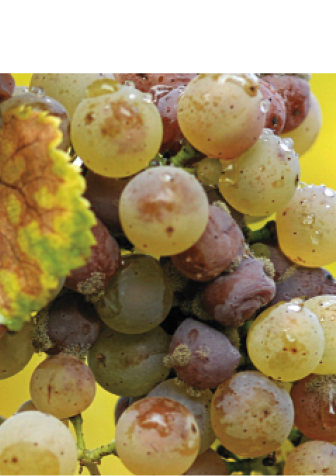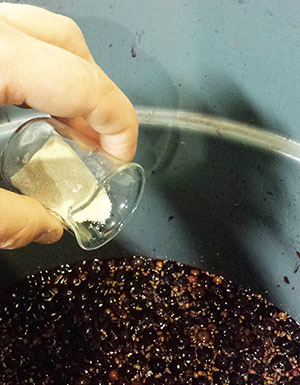
You’ve worked long and hard to craft that awesome red wine but now, you go down to the cellar to taste a sample out of the carboy or oak barrel to see how the wine is coming along. Oh no! The wine smells of vinegar, and worse yet, it reeks of nail polish remover. What could have gone wrong? Is the barrel spoiled? Can it be reused?
The culprit? Acetic acid bacteria . . . and what you are witnessing is volatile acidity, or simply VA as it’s referred to in wine-speak.
This happens all too often, even to experienced winemakers and, perhaps surprisingly, in commercial winemaking. And unfortunately, novices not familiar with the symptoms often submit VA-afflicted wines into competitions only to be devastated when results are communicated back.
Here, we will look at the possible sources and root causes of volatile acidity in grapes — yes, it can start in the fruit — and wine, as well as how to detect, measure, and prevent VA.
THE GOOD AND THE BAD
Volatile acids are so-called because they are steam-distillable and all contribute to VA. Although wine contains several minor volatile acids, acetic acid (or, ethanoic acid) is the single most important one. It imparts a vinegar-like smell in what is referred to as acetic acid spoilage, or simply VA, and can make a wine limp and flat. Minor volatile acids include formic, propionic, butyric, isobutyric, and isovaleric acids, which can impart a range of unpleasant off-odors such as cheese, sauerkraut, sweat, or a rancid odor.
But a small amount of acetic acid below its detection threshold in wine is desirable as it can increase organoleptic complexity, particularly in sweet-style wines such as Sauternes and ice wine, where higher levels are inevitably found as yeast metabolizes greater amounts of sugar into more acetic acid. VA magnifies the taste of fixed acids (e.g., tartaric and malic acid) and tannins but, itself, is masked by high levels of sugar and ethanol.
In table wines, normal VA levels are in the range 100–400 mg/L. Detection threshold is around 600 mg/L; wine becomes objectionable at concentrations exceeding 1,000 mg/L (1 g/L) depending on style of wine, and is considered spoiled above 2 g
SOURCES & CAUSES OF VA
Acetic acid is found in trace amounts in healthy grapes but in much higher concentrations in grapes affected by Botrytis cinerea, the mold responsible for gray rot as is pictured in the grapes at the top of this page.
Yeast and bacteria do not use acetic acid as a substrate but do metabolize non-negligible amounts. Yeast produces small amounts of it as part of their metabolism in the normal course of alcoholic fermentation. Different strains produce varying amounts. Manufacturers of cultured yeast often provide some indication (low, medium, high) of the amount of VA each strain produces.
Fermentation conditions that stress yeast can also increase acetic acid production. These include excessive yeast assimilable nitrogen (YAN), high amounts of calcium in the must, very low pH must, high fermentation temperatures, and oxygen deficiency during the critical yeast growth phase.
The main culprits of VA are, however, acetic acid bacteria (AAB), so-called because of their ability to partially metabolize ethanol into acetic acid, in what is known as ethanol acetification. AAB first oxidize ethanol into acetaldehyde with the help of alcohol dehydrogenase (ADH) enzymes and then into acetic acid using aldehyde dehydrogenase (ALDH) enzymes.
AAB include bacteria from Gluconobacter spp. and Acetobacter spp. Gluconobacter bacteria tend to manifest themselves on grapes and in must whereas Acetobacter occur mainly in wine. The challenge with AAB is that, although they need oxygen to grow, they can survive under anaerobic conditions and manifest their spoilage power once oxygen becomes available. Some AAB can also metabolize organic acids, mainly lactic acid, via a similar oxidative process.
In general, AAB thrive in an environment of relatively high pH, warm temperatures, low ethanol levels, and a good supply of oxygen and ammonium. Some strains also have fairly good resistance to sulfur dioxide (SO2).
Since AAB need oxygen to thrive, the root cause is usually poorly topped carboys or barrels, but it can also be due to excessive oxygen uptake from aggressive processing or excessive ingress oxygen via defective equipment, such as a bad fermentation lock, a damaged tank lid seal, and a leaky barrel. Wine, and particularly reds during maceration, should be well protected from fruit flies as they are carriers of AAB. All organic waste (stems, spilled cracked grape berries, etc.) should be discarded from the winemaking area immediately after crushing/pressing.
Acetic acid can also result from the metabolic activity in lactic acid bacteria (LAB), including Oenococcus and Lactobacillus. Oenococcus bacteria are used for malolactic fermentation (MLF) whereas Lactobacillus are usually associated with LAB spoilage. LAB can use sugars, fixed acids, namely tartaric, malic and citric acid, as substrates to produce acetic acid. As tartaric acid degradation by LAB occurs under aerobic conditions and high pH, it is not common given the reductive environment in wine during MLF and aging. Citric acid is a more common problem given LAB’s appetite for this acid, hence the reason why citric acid additions are never recommended to increase acidity (tartaric acid is the recommended acid) particularly in wines that will be put through an MLF.
Wines affected by Brettanomyces yeast will also contain higher levels of acetic acid. B. bruxellensis is a ubiquitous spoilage yeast, often referred to as “Brett,” which imparts a strong barnyard or Band-Aid-like smell. The yeast is part of the vineyard’s natural microflora residing on grape berries, particularly overripe and Botrytis-affected grapes, and is transported into the winery with the harvest. Red wines are more prone to infection because grapes are normally harvested at greater phenolic ripeness compared to white varieties, and then allowed to macerate unlike in white winemaking. As the yeast thrives in barrels, oak-aged reds are most prone to Brett. Dry reds are as much at risk as the yeast is capable of converting very low levels of glucose (as low as 275 mg/L) into acetic acid.
DETECTING VA
VA is often detected too late to be able to take any corrective actions because ethyl acetate is detected before acetic acid by virtue of its lower detection threshold, in the 160–180 mg/L. Ethyl acetate is the result of ethanol esterification by acetic acid and is easily detected as a solvent smell akin to nail polish remover. It can impart a particularly hot sensation to wine even at levels below detection; it is the cause of homemade wines of yesteryear described as “very strong” though incorrectly attributed to supposedly higher levels of ethanol. Only a tiny amount of ethanol, in the order of 0.01% v/v, and about 100 mg/L of acetic acid are sufficient to push ethyl acetate production over its detection threshold. If, however, acetaldehyde is detected, a sulfite addition can quickly bind this bruised-apple smelling compound into its odorless bound form. Acetaldehyde is the precursor to acetic acid and can be detected at low levels, in the 50–200 mg/L range.
A wine affected by excessive VA is best discarded. There are no effective treatments to remove VA other than by a very expensive reverse osmosis process. Perfectly good wine should never be blended with one affected by acetic acid as an attempt to improve it — it will not.
MEASURING VA
VA can be measured analytically by Cash distillation or enzymatic–UV spectrometric methods, the latter being expensive and the domain of advanced labs. A Cash Still will set you back $700 or more but it may be a wise investment if you intend to perform VA analysis on an ongoing basis. Alternatively, you can send samples out to a lab for about $25 per test.
A Cash Still comprises a boiling flask and distillation chamber to boil the sample and separate the volatile fraction, and a condenser to cool down and condense the steam into the distillate using running cold tap water. Choose the more practical albeit slightly more expensive version that includes a glass aspirator “pump” to easily remove the spent sample from the distillation chamber after use; it can otherwise be cumbersome and time-consuming.
The procedure involves distilling a small volume of wine to extract the volatile fraction, then titrating the distillate with sodium hydroxide (NaOH) as in total acidity (TA) titration. As acetic acid is the major acid in VA, measurements are reported in g/L expressed as acetic acid equivalent, just like TA is expressed as tartaric acid equivalent. Values are most commonly reported in mg/L as VA is normally under 1 g/L. A typical distillation uses a 10-mL sample to collect 100 mL of distillate; the additional volume comes from water, which has a lower boiling point than acetic acid (244 °F/118 °C).
As wine contains carbon dioxide (CO2) and SO2, volatile substances that would skew results, samples must be treated to ensure that these are excluded. CO2 can be removed by bringing the wine sample to a short, gentle boil, by stirring vigorously, or by sparging the sample with nitrogen gas. The latter method is the most expedient and most practical. SO2 is made to bind by adding pharmacy-grade hydrogen peroxide (H2O2).
For sweet wines, the analysis should be performed before adding any potassium sorbate (used to inhibit renewed fermentation), otherwise, its sorbic acid content will skew the results. Alternatively, VA measurements can be adjusted knowing that 1 g of sorbic acid (= 1.34 g of potassium sorbate) will measure 0.535 g of acetic acid.
VA is calculated using the amount of NaOH used in the titration as per the following equation:
VA (mg/L) = (mL NaOH x N NaOH x 60,000) / (mL of sample)
For example, if 1.2 mL of 0.1N NaOH were used to titrate 10 mL of wine sample in 100 mL of distillate, then:
VA (mg/L) = (1.2 x 0.1 x 60,000) / 10 = 720 mg/L
VA should be measured at crush or press to ensure that there are no problems before fermentation, particularly where grapes are damaged or showing some mold, and just before bottling.
10 TIPS AND BEST PRACTICES ON AVOIDING VA SPOILAGE
1. Discard any grape berries or bunches that have deteriorated or shriveled.
2. Choose a yeast strain with low VA production.
3. Protect fermenting wine from fruit flies. For reds, place a heavy tarp over the fermenting vat, and for
whites, protect the wine using a bung and fermentation lock on carboys.
4. Ferment wine within recommended temperatures.
5. Minimize the wine’s exposure to air during post-ferment cellar operations such as racking and filtering.
6. Keep carboys and barrels topped up properly during storage and aging. Use wine from a previous
vintage to top up, if necessary. When no wine is available, flush air out with an inert gas such as CO2, nitrogen, or argon, and quickly replace the bung on the carboy or barrel. However, gas is much less effective than topping up with sound wine and therefore you should not depend on this method for long-term storage.
7. Ensure that bungs or rubber stoppers form airtight seals on carboys and barrels, and check regularly the water/sulfite level in fermentation locks.
8. If you detect VA by smell, do NOT blend the wine with any other wine.
9. Maintain proper levels of TA, pH and free SO2 throughout winemaking, from crush to bottling.
10. Maintain at as cool a temperature as possible during wine storage or aging. Ideal temperature is 55 °F (13 °C).
And remember, if you smell a slight odor of VA during bulk aging but you consider the wine acceptable to your palate, bottle it quickly to put it under anaerobic conditions and minimize further spoilage. Drink young.






